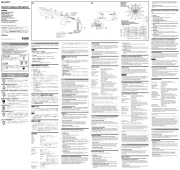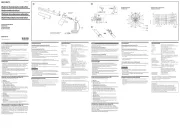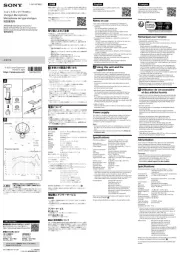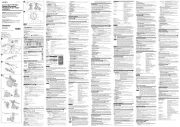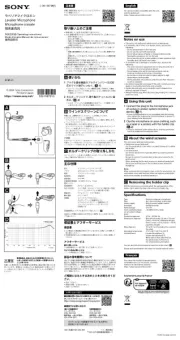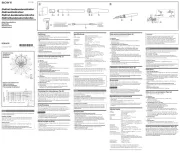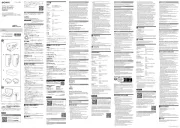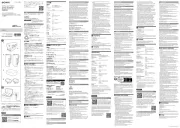
雨のあたる場所や、油煙、湯気、湿気、ほこりの多い場所に設
お買い上げいただきありがとうございます。お使いになる前に、この取扱説
鋭い指向性を持ち、卓上での集音をはじめ、屋外での狭角度集音やカム
不要なノイズや低音域をカットするローカットスイッチ付き
(文の番号と図の番号を照らし合わせてご覧ください。)
マイクで集音した音声が出力されます。また、電源が外部から供給され
マイクホルダー(カムコーダーに搭載または別売り)を介して、マイク
マイク本体 にかぶせて使うと、風や息がマイクに直接当たるときに
マイクロホンスタンド(別売り)にマイクを取り付けるときなどに使い
ます。角度調整部のネジがゆるんだときには、コインなどで締め付けて
マイクホルダー(別売り)を使ってカムコーダーに装着するときは、マ
の振動が気になる場合は、マイクスペーサー(成型タイプ)
をはがし( )、マイク本体に巻き付けます( )。
マークが上側にくるようにマイクホルダーに取り付ける
このマイクは外部給電方式専用です。マイクの出力端子 と外部電源機器
パワーサプライまたは相当品や、オーディオミキサー、または
カムコーダーのマイク端子を接続します。接続には、マイクケーブルをご使
このマイクには不平衡型ケーブルは使用できません。必ず平衡型ケーブ
マイクロホンは敏感です。落としたり、たたいたり、強いショックを与え
使用中、「ピー」という音(ハウリング)が発生することがあります。これ
は、スピーカーから出る音をマイクロホンが拾ってしまうために起こり
ます。ハウリングを防ぐには、マイクロホンとスピーカーを向き合わな
To camcorder input connector
Vers le connecteur d’entrée du
zum Eingangsanschluss des
Frequency response diagram
Diagramme de réponse de fréquence
レスポンス /Response/
Réponse /Ansprechen
Frequency/Fréquence/Frequenz
生する雑音出力の平均値を等価入力音圧に換算した値。(
仕様および外観は改良のため予告なく変更することがありますが、ご了承くだ
お使いになる前に、必ず動作確認を行ってください。故障その他に伴う営
業上の機会損失等は保証期間中および保証期間経過後にかかわらず、補償
この製品には保証書が添付されていますので、お買い上げの際お受け取りく
ださい。所定事項の記入および記載内容をお確かめのうえ、大切に保存して
お買い上げ店、または添付の「ソニーご相談窓口のご案内」にあるお近くの
保証書の記載内容に基づいて修理させて頂きます。詳しくは保証書をご
修理によって機能が維持できる場合は、ご要望により有料修理させて頂き
Before using the microphone, please read this manual thoroughly. This manual
should be retained for future reference.
For the customers in Europe
This product is intended for use in the following Electromagnetic
Environments: E1 (residential), E2 (commercial and light industrial), E3 (urban
outdoors), E4 (controlled EMC environment, ex. TV studio).
For the customers in the U.S.A.
- Please visit http://www.sony.com/psa/
warranty for important information and complete terms and conditions of
Sony’s limited warranty applicable to this product.
For the customers in Canada
- Please visit http://www.sonybiz.ca/pro/lang/
en/ca/article/resources-warranty for important information and complete
terms and conditions of Sony’s limited warranty applicable to this product.
For the customers in Europe
Sony Professional Solutions Europe - Standard Warranty and Exceptions
Please visit https://pro.sony/en_GB/support-services/warranty/support-
professional-solutions-europe-standard-product-warranty for important
information and complete terms and conditions.
For the customers in Korea
- Please visit http://bpeng.sony.co.kr/handler/
BPAS-Start for important information and complete terms and conditions
of Sony’s limited warranty applicable to this product.
Super cardioid microphone with minimum sensitivity to ambient
The microphone’s sharp directivity makes it suitable for medium-distance
sound recording, such as on a desktop at conferences, narrow-angle sound
recording outdoors, or attachment to a camcorder.
Length of 200 mm and mass of 135 g, making it easy to use and carry.
LOW CUT switch which cuts unnecessary low-frequency noise
The low cut filter reduces the noise occurring due to wind or vibration.
External power supply type
Supports 40 V to 52 V DC external power supply.
Names and Functions of Parts (Fig. )
(The numbers refer to the corresponding numbers in the figure.)
The low cut filter reduces wind noise effectively.
) : The low cut filter is applied.
Output connector (XLR-3-12C type)
Outputs the sound captured by the microphone. It also supplies power
from the external power supply.
-a Microphone spacer (molded type) /
-b Microphone spacer (sheet
Use when attaching the microphone to a camcorder using a microphone
holder (supplied with the camcorder or available separately).
to reduce wind or breathing noise.
Use when attaching the microphone to a microphone stand (not supplied).
If the angle adjustment screw becomes loose, tighten it with a coin or
Use to connect the output connector
of the microphone to the input
connector (XLR type) of a camcorder (cable length: 500 mm).
Attaching to a Camcorder (Fig. )
When attaching the microphone to a camcorder using a microphone holder
(not supplied), attach the supplied microphone spacer (molded type)
). If vibration from the camcorder is of concern, use the
microphone spacer (sheet type)
-b instead. Remove the two release sheets
) and wrap the spacer around the microphone grip (
Attach the microphone to the holder so that the “UP” mark on the
microphone faces upward to obtain correct directivity.
This microphone is powered only from an external supply. Connect the output
of the microphone to an external power supply device, such as a Sony
AC power supply or equivalent device, or the microphone connector of an audio
mixer or camcorder. For connection, use a microphone cable.
Before connecting the microphone to a camcorder or other device, check
that it is equipped with a 40 V to 52 V microphone input connector.
An unbalanced cable cannot be used with this microphone. Be sure to use a
balanced microphone cable.
Microphones are delicate. Do not drop, hit, or subject it to excessive shock.
Avoid extended usage or storage in high humidity or temperatures above
If acoustic feedback occurs during use (a howling sound is heard from the
speakers), point the microphone away from the speakers or increase the
distance between the microphone and the speakers.
Type Electret condenser microphone
Power supply External power supply 40 V to 52 V DC
Current consumption 2 mA or less
Output connector XLR-3-12C type
Dimensions ø20 × 200 mm (ø
Mass Approx. 135 g (4.8 oz)
Supplied accessories Wind screen (1), microphone holder (1),
microphone spacer (2), microphone cable (1),
stand adaptor (2), Operating Instructions (1),
Frequency response 40 Hz to 20,000 Hz
Directivity Super cardioid
Output impedance 220 Ω ± 20% (1 kHz), balanced
Sensitivity (typ) −36 dB (15.8 mV) (0 dB = 1 V/Pa at 1 kHz)
Signal-to-noise ratio 77 dB (typ) (IEC 179 A-weighted, 1 kHz, 1 Pa)
Inherent noise 17 dB SPL (typ) (0 dB SPL = 2 × 10
Wind noise* 45 dB SPL or less (with wind screen)
50 dB SPL or less (without wind screen)
Maximum input sound pressure level
124 dB SPL (typ) (input level for 1% output signal
waveform distortion at 1 kHz, converted into
equivalent sound pressure level: 0 dB SPL = 2 ×
Dynamic range 107 dB (typ)
Operating temperature 0 °C to 50 °C (32 °F to 122 °F)
Storage temperature −20 °C to +60 °C (−4 °F to +140 °F)
* Wind noise is the value measured by applying a wind velocity of 2 m/s (6.6
ft/s) to the microphone from all directions. The noise output mean value is
converted to the equivalent input sound pressure level (0 dB SPL = 2 × 10
Design and specifications are subject to change without notice.
Always verify that the unit is operating properly before use. SONY WILL
NOT BE LIABLE FOR DAMAGES OF ANY KIND INCLUDING, BUT
NOT LIMITED TO, COMPENSATION OR REIMBURSEMENT ON
ACCOUNT OF THE LOSS OF PRESENT OR PROSPECTIVE PROFITS
DUE TO FAILURE OF THIS UNIT, EITHER DURING THE WARRANTY
PERIOD OR AFTER EXPIRATION OF THE WARRANTY, OR FOR ANY
Avant d’utiliser ce microphone, lisez attentivement ce mode d’emploi à
conserver pour toute référence ultérieure.
Pour les clients en Europe
Ce produit est prévu pour être utilisé dans les environnements
électromagnétiques suivants : E1 (résidentiel), E2 (commercial et industrie
légère), E3 (urbain extérieur) et E4 (environnement EMC contrôlé, ex. studio
Pour les clients au Canada
- Rendez-vous sur http://www.sonybiz.ca/
pro/lang/en/ca/article/resources-warranty pour obtenir les informations
importantes et l’ensemble des termes et conditions de la garantie limitée de
Sony applicable à ce produit.
Microphone supercardioïde peu sensible aux bruits ambiants
Sa directivité extrêmement prononcée permet d’utiliser le microphone pour
des enregistrements à distance moyenne, par exemple depuis un bureau lors
de conférences, pour des enregistrements audio à angle étroit en extérieur ou
de le fixer sur un caméscope.
Longueur de 200 mm et poids de 135 g : facilitent l’utilisation et le transport.
Commutateur LOW CUT coupant le bruit basse fréquence inutile
Le filtre passe-bas réduit le bruit provoqué par le vent ou les vibrations.
Type à alimentation externe
Compatible avec une alimentation externe 40 V à 52 V CC.
(Les numéros correspondent à ceux des illustrations.)
Le filtre passe-bas réduit efficacement le bruit du vent.
) : le filtre passe-bas est utilisé.
Connecteur de sortie (type XLR-3-12C)
Émet le son capturé par le microphone. Il fournit également l’énergie
provenant de l’alimentation externe.
-a Bague d’adaptation de microphone (type moulé) /
d’adaptation de microphone (type feuille)
Utilisez-la lorsque vous fixez le microphone sur un caméscope à l’aide
d’un support de microphone (fourni avec le caméscope ou disponible
pour réduire le bruit du vent ou de la
Utilisez-le lorsque vous fixez le microphone sur un pied (non fourni). Si la
vis de réglage de l’angle se desserre, resserrez-la à l’aide d’une pièce ou d’un
Utilisez-le pour brancher le connecteur de sortie
connecteur d’entrée (type XLR) d’un caméscope (longueur du câble :
Fixation sur un caméscope (fig. )
Pour fixer le microphone sur un caméscope à l’aide d’un support de
(non fourni), fixez la bague d’adaptation fournie (type moulé)
). Si les vibrations du caméscope sont gênantes,
utilisez plutôt la bague d’adaptation du microphone (type feuille)
les deux feuilles détachables (
) et placez la bague d’adaptation sur la poignée
Fixez le microphone au support de sorte que le repère « UP » du microphone
soit orienté vers le haut pour obtenir la bonne directivité.
Ce microphone n’est alimenté que par une alimentation externe. Branchez le
du microphone à un dispositif d’alimentation externe,
par exemple une alimentation secteur Sony ou un dispositif équivalent, ou au
connecteur du microphone d’un mixeur audio ou d’un caméscope. Utilisez un câble
de microphone pour le raccordement.
Avant de connecter le microphone à un caméscope ou un autre appareil,
vérifiez qu’il dispose d’un connecteur d’entrée de microphone de 40 V à 52 V.
Vous ne pouvez pas utiliser de câble asymétrique avec ce microphone.
Veillez à utiliser un câble de microphone symétrique.
Remarques à propos de l’utilisation
Les microphones sont fragiles. Ne les laissez pas tomber, se cogner ou subir
Évitez de les utiliser ou de les stocker trop longtemps dans des
environnements où l’humidité est élevée ou les températures dépassent 60 °C
En cas de rétroaction acoustique pendant l’utilisation (les haut-parleurs
émettent un sifflement), dirigez le microphone dans la direction opposée aux
haut-parleurs ou éloignez-le de ces derniers.
Caractéristiques techniques
Type Microphone condensateur à électret
Alimentation Alimentation externe 40 V à 52 V CC
Consommation électrique 2 mA ou moins
Connecteur de sortie type XLR-3-12C
Dimensions ø20 × 200 mm (ø
Poids Environ 135 g (4,8 onces)
Accessoires fournis Bonnette anti-vent (1), support de microphone
(1), bague d’adaptation du microphone (2), câble
de microphone (1), adaptateur de pied (2), Mode
d’emploi (1), livret de garantie (1)
Réponse en fréquence 40 Hz à 20 000 Hz
Directivité Supercardioïde
Impédance de sortie 220 Ω ± 20% (1 kHz), symétrique
Sensibilité (typique) −36 dB (15,8 mV) (0 dB = 1 V/Pa à 1 kHz)
Rapport signal/bruit 77 dB (typique) (IEC 179, pondération A, 1 kHz,
Bruit inhérent 17 dB SPL (typique) (0 dB SPL = 2 × 10
Bruit du vent* 45 dB SPL ou moins (avec bonnette anti-vent)
50 dB SPL ou moins (sans bonnette anti-vent)
Niveau de pression acoustique d’entrée maximale
124 dB SPL (typique) (niveau d’entrée pour une
distorsion ondulatoire du signal de sortie de 1% à
1 kHz, convertie en niveau de pression acoustique
équivalent : 0 dB SPL = 2 × 10
Plage dynamique 107 dB (typique)
Température de fonctionnement
0 °C à 50 °C (32 °F à 122 °F)
Température de stockage −20 °C à +60 °C (−4 °F à +140 °F)
* Le bruit du vent correspond à la valeur mesurée quand le microphone est
soumis à un vent d’une vitesse de 2 m/s (6,6 pi/s) provenant de toutes les
directions. La valeur moyenne de la sortie de bruit est convertie en niveau de
pression acoustique d’entrée équivalent (0 dB SPL = 2 × 10
La conception et les caractéristiques techniques sont sujettes à modification
Vérifiez toujours que l’appareil fonctionne correctement avant l’utilisation.
Sony n’assumera pas de responsabilité pour les dommages de quelque
sorte qu’ils soient, incluant mais ne se limitant pas à la compensation ou
au remboursement, à cause de la perte de profits actuels ou futurs suite à
la défaillance de cet appareil, que ce soit pendant la période de garantie
ou après son expiration, ou pour toute autre raison quelle qu’elle soit.
Vor dem Betrieb des Mikfrofons lesen Sie bitte diese Anleitung gründlich
durch. Bewahren Sie die Anleitung zum Nachschlagen auf.
Für die folgenden elektromagnetischen Umgebungen: E1 (Wohnbereich),
E2 (kommerzieller und in beschränktem Maße industrieller Bereich),
E3 (Stadtbereich im Freien) und E4 (kontrollierter EMV-Bereich, z.B.
Mikrofon mit Supernierencharakteristik und geringstmöglicher
Empfindlichkeit für Umgebungsgeräusche
Durch die ausgeprägte Richtwirkung eignet sich dieses Mikrofon für
Tonaufnahmen aus mittlerer Entfernung wie auf einem Konferenztisch, für
stark gerichtete Tonaufnahmen im Freien oder in Kombination mit einem
Durch die geringe Länge von 200 mm und einem Gewicht von 135 g ist das
Mikrofon leicht zu verwenden und zu transportieren.
ソニー製品は安全に充分に配慮して設計されています。しかし、製品は、まち
がった使いかたをすると、けがにつながることがあり、危険です。
長期間安全にお使いいただくために、定期点検をすることをおすすめしま
す。点検の内容や費用については、お買い上げ店にご相談ください。
故障したら使わずに、お買い上げ店にご相談ください。
Electret Condenser Microphone
Инструкция по эксплуатации
電気製品は、安全のための注意事項を守らないと、けがをした
この取扱説明書には、事故を防ぐための重要な注意事項と製品の取り扱いか
たを示してあります。この取扱説明書をよくお読みのうえ、製品を安全にお使
いください。お読みになったあとは、いつでも見られるところに必ず保管して
LOW CUT-Schalter zum Ausblenden von tieffrequenten Störungen
Dieser Rumpelfilter verringert durch Wind und Vibration verursachte
Unterstützt externe Stromversorgung mit einer Gleichspannung von 40 V
Bezeichnungen und Funktionen der Teile (Abb.
(Die Nummern entsprechen den jeweiligen Nummern in der Abbildung.)
Der Rumpelfilter verringert Windgeräusche wirksam.
) : Rumpelfilter aktiviert
Ausgangsanschluss (Typ XLR-3-12C)
Gibt den vom Mikrofon erfassten Ton aus. Dient außerdem zur externen
-a Mikrofon-Distanzstück (Formstück) /
Zum Anbringen des Mikrofons an einem Camcorder mithilfe eines
Mikrofonhalters (zum Camcorder mitgeliefert oder separat erhältlich).
anbringen, um Wind- oder Atemgeräusche zu
Zum Anbringen des Mikrofons an einem Mikrofonständer (nicht
mitgeliefert). Wenn die Winkeleinstellschraube locker geworden ist, mit
einer Münze o. ä. festziehen.
Dient zum Verbinden des Ausgangsanschlusses
Eingangsanschluss (Typ XLR) eines Camcorders (Kabellänge: 500 mm).
Anbringen an einem Camcorder (Abb. )
Beim Anbringen des Mikrofons an einem Camcorder mithilfe eines
(nicht mitgeliefert) bringen Sie das mitgelieferte
Mikrofon-Distanzstück (Formstück)
Gefahr bestehen, dass der Camcorder Vibrationen ausgesetzt wird, verwenden
Sie stattdessen das Mikrofon-Distanzstück (flach)
) und wickeln Sie das Distanzstück (flach) um den
Bringen Sie das Mikrofon danach so am Halter an, dass die Markierung
„UP“ nach oben weist, um die vorgesehene Richtwirkung zu erhalten.
Das Mikrofon kann nur von einer externen Stromquelle versorgt werden. Verbinden
Sie den Ausgangsanschluss
des Mikrofons mit dem Mikrofonanschluss einer
externen Stromversorgung wie beispielsweise ein AC-Netzteil von Sony oder ein
gleichwertiges Gerät, eines Audiomischpults oder eines Camcorders. Verwenden
Sie zur Verbindung ein Mikrofonkabel.
Bevor Sie das Mikrofon mit einem Camcorder oder einem anderen Gerät
verbinden, prüfen Sie, ob dieses über einen Mikrofoneingangsanschluss mit
einer Versorgungsspannung von 40 V bis 52 V verfügt.
Ein unsymmetrisches Kabel kann nicht mit diesem Mikrofon verwendet
werden. Verwenden Sie immer ein symmetrisches Mikrofonkabel.
Mikrofone sind empfindlich. Lassen Sie diese nicht fallen und schützen Sie
Vermeiden Sie längere Verwendung oder Lagerung des Mikrofons bei hoher
Luftfeuchtigkeit oder Temperaturen über 60 °C.
Wenn bei der Verwendung akustische Rückkopplung auftritt (es kommen
Heulgeräusche von den Lautsprechern), richten Sie das Mikrofon von
den Lautsprechern weg, oder vergrößern Sie seinen Abstand zu den
Typ Elektret-Kondensatormikrofon
Stromversorgung externe Stromversorgung 40 V bis 52 V DC
Stromaufnahme 2 mA oder weniger
Ausgangsanschluss Typ XLR-3-12C
Mitgeliefertes Zubehör Windschutz (1), Mikrofonhalter (1), Mikrofon-
Distanzstück (2), Mikrofonkabel (1), Standadapter
(2), Bedienungsanleitung (1), Garantieheft (1)
Frequenzgang 40 Hz bis 20.000 Hz
Richtcharakteristik Superniere
Ausgangsimpedanz 220 Ω ±20% (1 kHz), symmetrisch
Empfindlichkeit (typ.) −36 dB (15,8 mV) (0 dB = 1 V/Pa bei 1 kHz)
Signal-Rausch-Abstand 77 dB (typ.) (IEC 179 A-gewichtet, 1 kHz, 1 Pa)
Grundrauschen 17 dB SPL (typ.) (0 dB SPL = 2 × 10
Windrauschen* 45 dB SPL oder weniger (mit Windschutz)
50 dB SPL oder weniger (ohne Windschutz)
Maximaler Eingangsschalldruckpegel
124 dB SPL (typ.) (Eingangspegel bei 1%
Wellenformverzerrung des Ausgangssignals
bei 1 kHz, umgewandelt in entsprechenden
Schalldruckpegel: 0 dB SPL = 2 × 10
Dynamikumfang 107 dB (typ.)
Betriebstemperatur 0 °C bis 50 °C
Temperatur bei Lagerung −20 °C bis +60 °C
* Zur Messung des Windgeräusches wird das Mikrofon einem Wind mit
einer Geschwindigkeit von 2 m/s aus allen Richtungen ausgesetzt. Der
Durchschnittswert wird dann in den äquivalenten Eingangsschalldruckpegel
umgerechnet (0 dB SPL = 2 × 10
Gestaltung und technische Daten können jederzeit ohne Ankündigung
Bestätigen Sie vor dem Gebrauch immer, dass das Gerät richtig arbeitet.
SONY KANN KEINE HAFTUNG FÜR SCHÄDEN JEDER ART,
EINSCHLIESSLICH ABER NICHT BEGRENZT AUF KOMPENSATION
ODER ERSTATTUNG, AUFGRUND VON VERLUST VON AKTUELLEN
ODER ERWARTETEN PROFITEN DURCH FEHLFUNKTION DIESES
GERÄTS ODER AUS JEGLICHEM ANDEREN GRUND, ENTWEDER
WÄHREND DER GARANTIEFRIST ODER NACH ABLAUF DER
GARANTIEFRIST, ÜBERNEHMEN.
Prima di usare il microfono, leggere con attenzione questo manuale.
Conservare questo manuale per eventuali riferimenti futuri.
Questo prodotto è destinato all’uso nei seguenti ambienti elettromagnetici: E1
(residenziali), E2 (commerciali e industriali leggeri), E3 (esterni urbani) e E4
(ambienti EMC controllati, ad esempio studi televisivi).
Microfono supercardioide con minima sensibilità al rumore
La precisa direzionalità del microfono lo rende idoneo per la registrazione
del suono a media distanza, ad esempio su un tavolo durante conferenze,
per registrazioni in esterni entro un campo ristretto, oppure montato su un
Con una lunghezza di 200 mm e un peso di 135 g, il microfono può essere
utilizzato e trasportato con facilità.
Selettore LOW CUT per il taglio dei rumori a bassa frequenza
Il filtro taglia bassi riduce il rumore dovuto al vento o alle vibrazioni.
Consente l’utilizzo di una sorgente di alimentazione esterna con tensione
compresa fra 40 Vcc e 52 Vcc.
